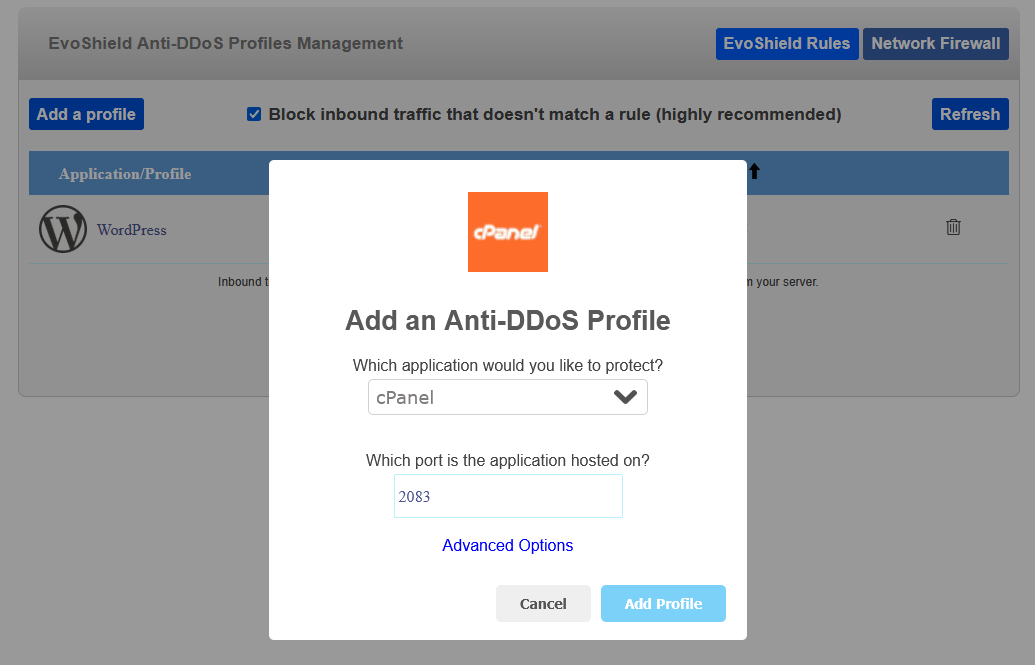🛡️ Why Web Hosting DDoS Protection Matters

Today’s websites and online services face constant threats — one of the most disruptive being DDoS (Distributed Denial of Service) attacks. These floods of malicious traffic can grind your site to a halt, interrupt services, and cause significant loss of revenue or user trust. Whether you're running a small business website or an online platform serving thousands, having DDoS protected web hosting is no longer optional — it’s essential.
Understanding DDoS Attacks
DDoS attacks attempt to overwhelm your hosting providers web server by flooding it with fake or automated requests. These may target your bandwidth, exploit network vulnerabilities, or overload specific services such as login portals or payment APIs. The result: slow performance, errors, or full website downtime.
Major DDoS Attack Categories
- Network Floods: Saturate your bandwidth using junk traffic (UDP floods, ICMP floods).
- State Exhaustion: Exploit server resource limits with attacks like SYN floods.
- Application-Level Floods: Target web apps with fake logins, searches, or API calls to consume CPU.
Self-Managed Web Hosting DDoS Protection Techniques
If you have full Administrator (for Windows) or root (for Linux) access to the server hosting the website, here are some hands-on ways to strengthen the resilience of the site:
-
Use Access Control Rules to Block Abusive IPs
To prevent malicious traffic from specific IP addresses, you can block them directly at the web server level. Below are examples for both Apache and Nginx, including where to place the rules:
🔧 Apache (2.4+)
Add the following to your.htaccessfile (located in your website root directory, e.g.,/var/www/html/.htaccess):# Block a specific IP in Apache (.htaccess) Require all granted Require not ip 45.33.32.156If you prefer to apply the rule globally or to a specific directory in the Apache config file (e.g.,
/etc/apache2/sites-available/000-default.conf), you can use:<Directory "/var/www/html"> Require all granted Require not ip 45.33.32.156 </Directory>🔧 Nginx
To block an IP in Nginx, edit your site’s configuration file (commonly found in/etc/nginx/sites-available/):# Inside server or location block deny 45.33.32.156; allow all;After modifying the Nginx config, reload the service to apply changes:
sudo systemctl reload nginx💡 Tip: Use your server's access logs (e.g.,
/var/log/apache2/access.logor/var/log/nginx/access.log) or a control panel’s analytics to identify suspicious IPs that are consuming excessive resources. -
Install Server-Side Rate Limiting Tools
Prevent repetitive hits from overwhelming your system by setting request thresholds:
mod_evasive– Apache module to block repeated page requestsFail2Ban– Linux tool that monitors log files and bans IPs based on patterns
-
Cache Static Assets and Minimize Dynamic Requests
Offload traffic by serving static content directly and caching pages:
- cPanel users: Enable caching via built-in caching plugins or through `.htaccess` rules
- Nginx users: Use `expires` and `cache-control` headers to reduce server load
-
Secure Admin and API Endpoints
Protect login panels, dashboards, and API gateways using:
# Restrict by IP location /admin { allow 192.0.2.0; deny all; }You can also add HTTP authentication to sensitive areas using `.htpasswd` and server config.
-
Reduce Attack Surface
- Close unused ports
- Disable directory listings
- Keep software, themes, and scripts updated
- Use a lightweight front-end theme to reduce server load (resource usage) and increase site performance
Professional-Grade DDoS Protected Web Hosting with EvoShield

Choose a Web Hosting Anti-DDoS Method
🛡️ EvoShield Remote Protection filters malicious traffic before it reaches your web server — no migration required.
Enable Remote Website Anti-DDoS🖥️ Protected VPS Hosting with Evolution Host ensures your web hosting environment is secured by default.
Get an Anti-DDoS Web Hosting VPSWhile manual server hardening is useful, it doesn’t scale against sustained or advanced DDoS attacks. That’s where Evolution Host’s EvoShield protection comes in. EvoShield offers real-time filtering and mitigation at the network edge — stopping threats before they reach your server.
How You Can Use EvoShield
- Remote Protection: Add EvoShield to your existing server — no migration required.
- Web Hosting VPS with DDoS Defense: Host directly on Evolution Host for integrated web hosting protection.
Remote Web Hosting DDoS Protection
- Choose a plan via the Remote Protection page.
- Easily connect your server to the EvoShield network via a secure tunnel using the one-click install EvoShield router.
- Apply the web hosting DDoS protection profile via the client area.
- Go back to running your website - We're handling the attacks now.
Protection Inside A Web Host VPS
- Select a VPS plan at Evolution Host VPS Hosting If you need more power, opt for an Evolution Host VDS.
- Deploy your site or application as usual via SSH or a control panel.
- Enable the protection profile from the EvoShield dashboard.
- Sit back and enjoy your web hosting VPS with DDoS protection - all powered by EvoShield.
Benefit from network-layer filtering, zero setup complexity, and high-performance infrastructure.
Compatible with Popular Control Panels
Whether you're using a shared hosting environment or managing your own VPS or dedicated server, EvoShield is fully compatible with the most commonly used web hosting control panels. You don’t need to change your workflow — just activate protection and continue managing your websites as usual.
Supported Panels Include:
- cPanel / WHM: Full compatibility with all cPanel-managed sites. EvoShield works independently of your panel configuration and protects services like Apache, Nginx and LiteSpeed.
- DirectAdmin: Fully compatible with DirectAdmin-managed web servers and supports integration with both Apache and Nginx-based stacks.
- WordPress: WordPress based sites are fully compatible with the Anti DDoS web hosting stack. Read more about our WordPress DDoS protection here.
- Webmin / Virtualmin: EvoShield does not interfere with system-level configurations managed through Webmin and is effective for all hosted domains.
- ISPConfig, CyberPanel, VestaCP, and others: If your control panel runs on a standard Linux stack with public IP access, EvoShield will operate as intended.
No Plugin Needed: EvoShield operates at the network level, meaning you don’t need to install any software inside your panel — it protects all hosted sites and services, regardless of how many domains or accounts you manage.
💡 This makes EvoShield ideal for resellers, agencies, and multi-site operators who need seamless protection without disrupting control panel operations.
💬 What Our Clients Are Saying
Under Attack Now?
If you're experiencing an active attack, take action immediately:
- Identify spike patterns in your logs and block the malicious IPs using a firewall
- Enable or tighten any available firewall rules
- Activate EvoShield Remote Protection
- Consider migrating to an Evolution Host web hosting VPS or VDS.
Final Advice
No business or project is too small to be targeted. Botnets don’t discriminate — and downtime can happen when you least expect it. Whether you're hosting an API, a storefront, or a gameserver website, don’t leave your hosting exposed. Combine smart configurations with robust protection for maximum uptime and reliability.
Frequently Asked Questions
What is DDoS protected web hosting?
DDoS protected web hosting includes built-in mechanisms to detect and mitigate high-volume and sophisticated denial-of-service attacks, ensuring your website stays available during malicious traffic surges.
What is the difference between a DDoS and a DoS attack?
A DoS (Denial of Service) attack comes from a single source and is easier to block. A DDoS (Distributed Denial of Service) attack uses multiple compromised devices (botnets) across the internet, making it harder to detect and mitigate.
How can I tell if my website is under a DDoS attack?
Common signs include slow page loads, unusually high bandwidth usage, increased server CPU load, or total inaccessibility. Reviewing server logs and traffic spikes can help confirm a DDoS attack.
How long do DDoS attacks usually last?
DDoS attacks can last anywhere from a few minutes to several days. Some attacks are short-lived and part of an extortion scheme, while others are sustained to cause prolonged disruption or test infrastructure limits.
Can a firewall stop a DDoS attack?
Traditional firewalls may block basic attacks but struggle against large-scale or application-layer DDoS attacks. For full protection, a dedicated anti-DDoS solution is usually required.
Is DDoS protection necessary for small websites?
Yes. Even small websites are often targeted by automated botnets or opportunistic attackers. A basic level of protection ensures uptime and reliability for your users, regardless of site size.
Can I use EvoShield with my current host?
Yes. EvoShield Remote Protection lets you shield your existing web host without migrating. You just need administrative/root access to configure routing automatically by installing the EvoShield Tunnel Manager application.
How is VPS hosting with EvoShield different?
Evolution Host VPS plans come with EvoShield protection already integrated. There's no extra setup — just choose your plan and activate the filtering profile for your application type.
Does this only work with web hosting?
No. EvoShield can protect any internet-facing service — websites, APIs, gaming servers, mail servers, and more.
Can EvoShield protect against Layer 7 (application layer) DDoS attacks?
Yes. EvoShield offers filtering tuned to recognize and block application-layer attacks, such as HTTP flood attempts targeting login pages, search endpoints, or cart checkout APIs.
Is EvoShield suitable for eCommerce websites?
Absolutely. EvoShield helps ensure uptime during traffic spikes or targeted attacks, which is critical for payment processing, inventory synchronization, and customer trust during peak sales events.
Will EvoShield slow down my website?
No. EvoShield is built for low-latency, high-speed traffic inspection and routing. In most cases, you won't notice any difference in performance — only that your website stays online during attacks.
Do I need technical knowledge to set up EvoShield?
Not at all. EvoShield includes guided setup instructions and one-click installer tools for remote protection. For VPS customers, protection is activated via the dashboard — no technical changes required.

